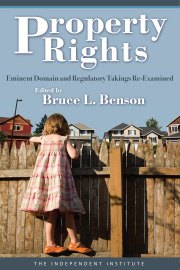An alternate version of this piece was published in the Los Angeles Business Journal on June 16, 2008.
----------
What if our affordable housing laws actually increased the cost of housing by 20 percent and decreased the number of available new homes by 10 percent? Wouldn’t that encourage us to take a serious look at what our housing policies are doing these days?
California’s courts don’t think so.
In 2001, when homebuilders challenged a local “inclusionary zoning” law (also known as an affordable housing law) requiring them to sell 10 percent of any homes, townhomes, condos, or apartments they build at an average of $300,000 less than the fair market price, the Court of Appeal sided with the government.
Writing for the majority in Home Builders Association of Northern California v. City of Napa, former Circuit Court Judge Scott Snowden said, “...it is beyond question that [the City of Napa’s] inclusionary zoning ordinance will ‘substantially advance’ the important governmental interest of providing affordable housing for low- and moderate-income families.” The ordinance, he concluded, “will necessarily increase the supply of affordable housing.”
The Court based its opinion partly on economic arguments. Now, in hindsight, we are able to test those arguments and see how they hold up against the evidence. We recently analyzed how inclusionary zoning laws requiring builders to set aside a given percentage of new construction for low- to moderate-income individuals have affected both new home prices and the quantity of new homes over time.
During the period we studied, the number of California cities with inclusionary zoning laws increased from 15 to 56. We compared the changes in housing prices and supply in these cities to those without a similar ordinance. The cities that adopted inclusionary zoning laws saw a 20 percent jump in housing prices and a 10 percent decrease in the number of new units built. This is the basic law of supply and demand at work. Affordable housing mandates have had an unintended consequence: they have discouraged homebuilding, and the diminished supply of housing has driven prices up.
When forced to sell at below-market rates due to this type of zoning, homebuilders must choose between decreasing the number of affordable units versus taking a loss. And, not surprisingly, they almost always choose decreasing the number of affordable units, which they accomplish by reducing the total number of planned units. In other words, since inclusionary zoning laws require developers to sell a percentage of all units they build at below-market rates in order to get permission to build market-rate units, the policy forces them to cut back on everything. With the number of new homes thus limited, buyers end up paying more for their homes.
Housing affordability is a major problem nationwide, but it is particularly acute in California. In San Francisco, where the median home price is now around $846,500 and the median household income is $86,100, only 7 percent of available houses are affordable for those whose income is in the median income range. In the Los Angeles-Long Beach-Glendale area, it’s even worse. The median home price in this area is $515,000; the median income is $61,700; and only 3.7 percent of homes are within a “doable” price range for the average family. In the San Diego area, only 10.1 percent of homes are within reach of the average family, and in San Jose, only 14.1 percent. The list goes on.
The last thing California families need is a law that makes housing even less affordable than it would be in the first place. Inclusionary zoning does just that.














